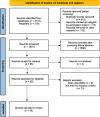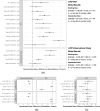The impact of the time factors on the exercise-based cardiac rehabilitation outcomes of the patients with acute myocardial infarction after percutaneous coronary intervention: a systematic review and meta-analysis
- PMID: 38184523
- PMCID: PMC10771662
- DOI: 10.1186/s12872-023-03692-z
The impact of the time factors on the exercise-based cardiac rehabilitation outcomes of the patients with acute myocardial infarction after percutaneous coronary intervention: a systematic review and meta-analysis
Abstract
Background and objective: Cardiac rehabilitation (CR) has been demonstrated to improve outcomes in patients with acute myocardial infarction (AMI) after percutaneous coronary intervention (PCI). However, the optimal CR initiation time and duration remain to be determined. This study aimed to explore the impact of the time factors on the CR outcomes in AMI patients who received PCI by the method of meta-regression analysis.
Methods: We searched five databases (PubMed, Embase, Cochrane Library, Web of Science and Google scholar) up to October 31, 2023. Meta-regression analysis was utilized to explore the impact of the time factors on the effect sizes. Subgroups with more than 3 studies were used for meta-regression analysis.
Results: Our analysis included 16 studies and a total of 1810 patients. The meta-regression analysis revealed that the initiation time and duration of CR had no significant impact on the occurrence of arrhythmia, coronary artery restenosis and angina pectoris. The initiation time and duration of CR also had no significant impact on the changes in left ventricular ejection fraction (LVEF, starting time: estimate = 0.160, p = 0.130; intervention time: estimate = 0.017, p = 0.149), left ventricular end-diastolic volume (LVEDV, starting time: estimate = - 0.191, p = 0.732; intervention time: estimate = - 0.033, p = 0.160), left ventricular end-systolic volume (LVESV, starting time: estimate = - 0.301, p = 0.464; intervention time: estimate = 0.015, p = 0.368) and 6-minute walk test (6MWT, starting time: estimate = - 0.108, p = 0.467; intervention time: estimate = 0.019, p = 0.116).
Conclusion: Implementation of CR following PCI in patients with AMI is beneficial. However, in AMI patients, there is no significant difference in the improvement of CR outcomes based on different CR starting times within 1 month after PCI or different durations of the CR programs. It indicates that it is feasible for patients with AMI to commence CR within 1 month after PCI and continue long-term CR, but the time factors which impact CR are intricate and further clinical research is still needed to determine the optimal initiation time and duration of CR.
Keywords: Acute myocardial infarction; Cardiac rehabilitation; Meta-analysis; Percutaneous coronary intervention; Time.
© 2024. The Author(s).
Conflict of interest statement
The authors declare no competing interests.
Figures





Similar articles
-
Effect of Exercise-Based Cardiac Rehabilitation on Left Ventricular Function in Asian Patients with Acute Myocardial Infarction after Percutaneous Coronary Intervention: A Meta-Analysis of Randomized Controlled Trials.Healthcare (Basel). 2021 Jun 21;9(6):774. doi: 10.3390/healthcare9060774. Healthcare (Basel). 2021. PMID: 34205597 Free PMC article.
-
Cardiac rehabilitation in acute myocardial infarction patients after percutaneous coronary intervention: A community-based study.Medicine (Baltimore). 2018 Feb;97(8):e9785. doi: 10.1097/MD.0000000000009785. Medicine (Baltimore). 2018. PMID: 29465559 Free PMC article.
-
Effect analysis of kinetic energy progressive exercise in patients with acute myocardial infarction after percutaneous coronary intervention: a randomized trial.Ann Palliat Med. 2021 Jul;10(7):7823-7831. doi: 10.21037/apm-21-1478. Ann Palliat Med. 2021. PMID: 34353069 Clinical Trial.
-
Effects of Exercise after Percutaneous Coronary Intervention on Cardiac Function and Cardiovascular Adverse Events in Patients with Coronary Heart Disease: Systematic Review and Meta-Analysis.J Sports Sci Med. 2019 Jun 1;18(2):213-222. eCollection 2019 Jun. J Sports Sci Med. 2019. PMID: 31191090 Free PMC article.
-
Effect of nicorandil treatment adjunctive to percutaneous coronary intervention in patients with acute myocardial infarction: a systematic review and meta-analysis.J Int Med Res. 2020 Nov;48(11):300060520967856. doi: 10.1177/0300060520967856. J Int Med Res. 2020. PMID: 33249959 Free PMC article.
Cited by
-
Part 2-Cardiac Rehabilitation After an Acute Myocardial Infarction: Timing and Gender Differences in Adherence; Where Do We Stand?J Clin Med. 2025 Feb 11;14(4):1189. doi: 10.3390/jcm14041189. J Clin Med. 2025. PMID: 40004720 Free PMC article. Review.
-
Exercise Training and Cardiac Rehabilitation in Patients After Percutaneous Coronary Intervention: Comprehensive Assessment and Prescription.J Clin Med. 2025 Feb 27;14(5):1607. doi: 10.3390/jcm14051607. J Clin Med. 2025. PMID: 40095584 Free PMC article. Review.
References
-
- Amsterdam EA, Wenger NK, Brindis RG, Casey DE, Jr, Ganiats TG, Holmes DR, Jr, et al. 2014 AHA/ACC guideline for the Management of Patients with non-ST-elevation acute coronary syndromes: a report of the American College of Cardiology/American Heart Association task force on practice guidelines. J Am Coll Cardiol. 2014;64(24):e139–e228. doi: 10.1016/j.jacc.2014.09.017. - DOI - PubMed
-
- Thomas RJ, Beatty AL, Beckie TM, Brewer LC, Brown TM, Forman DE, et al. Home-based cardiac rehabilitation: a scientific statement from the American Association of Cardiovascular and Pulmonary Rehabilitation, the American Heart Association, and the American College of Cardiology. J Am Coll Cardiol. 2019;74(1):133–153. doi: 10.1016/j.jacc.2019.03.008. - DOI - PMC - PubMed
Publication types
MeSH terms
LinkOut - more resources
Full Text Sources
Medical
Miscellaneous

